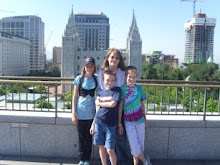Steve,
I was born in the Utah Valley Hospital in Provo on April 10, 1955. It was Easter Sunday. My parents lived on Geneva Road in what is now Vineyard (it was Vineyard then, too, but just a ward, not a city or town). I wasn’t very old when our family moved to Lakeview (again on Geneva Road, but much further south).
Kindergarten through 4th grade I went to Union Elementary School. It was on Geneva Road north of Vineyard. It was a two-story building with the Gym/lunchroom in a separate building next door. There was only one class for each grade and the kindergarten teacher taught 1st grade in the morning and kindergarten in the afternoon. The principal was principal in the morning and taught fifth grade in the afternoon. There was another teacher for morning fifth grade who taught at another school in the afternoon. The secretary was also the librarian. We didn’t have separate teachers for P.E., or music or art, and we didn’t have computers.
Every year the PTA held a Halloween party. We had dinner (usually sloppy joes and chips and homemade root beer), lots of games, a costume parade and a spook alley. We only went trick or treating to a few neighbors. The PTA also held a flower show each fall. Every spring we had a dance festival. Each grade would learn one or two dances to perform for the rest of the school and the parents.
When I was in fourth grade we studied Utah history. In the spring we went on a field trip to Salt Lake. We rode the school bus to Salt Lake and then we got to ride the train back to Provo. During my fourth grade year, Union School was condemned. For fifth and sixth grade I went to Cherry Hill. It was really different. Three classes for each grade and a lot of new kids. Lots of my best friends went to different schools and I didn’t see them again until High School.
In junior high I went to Lincoln Junior High. Again, it was an old school with two levels. The shop classes (wood and metal) were in a different building. Lincoln Jr. High used to be Lincoln High School. My dad went to school there and I had one of the same English teachers that he had. There was only one high school in Orem (Orem High) so everybody went to high school there (except one boy that went to BYU High until 11th grade when it was closed). We had our high school graduation in the Marriott Center on BYU Campus. We were seated alphabetically and I actually sat by a girl that I didn’t know.
We lived where most people considered it country and not close by many friends. There was only one other girl my age that lived very close by and I didn’t play with her very often. There were a lot of boys that lived across the street and next door, so I played with them. We played football and basketball. My older brother Fred taught me how to play basketball quite well. We liked to ride our bikes but there was no sidewalk on our side of the road. We had to cross Geneva Road to ride our bikes. We couldn’t cross the road during what was called shift change. Geneva Road was built so workers at Geneva Steel plant had a way to get to work. They worked 3 different shifts and when one shift ended and another one started, there was a lot of traffic on the road.
We always had a garden, and lots of times we used my grandmother’s field or my dad’s uncle’s field. Many years we grew corn, green beans, and tomatoes to sell. We used the money to pay for family vacations. We went to Yellowstone, and to the Seattle World’s Fair (and lots of other places because we usually went on a vacation every summer).
Television was black and white. My favorite show was "Perry Mason" but I could only watch it on Friday nights because it came on after the 10 o’clock news. My mom watched it every night (Monday-Friday).
For a long time, we shared our telephone line with our neighbors across the street. It was called a party line. Sometimes when we picked up the phone to call some one, the neighbors were already using their phone and we had to wait until they were done. If we were talking to some one and the neighbors wanted to use the phone, we could hear them pick up their phone. Then we would hurry to finish our call so they could use the phone line.
Hope this is helpful and not too long.
Love,
Grandma Jeppesen
A letter Grandma Jeppesen wrote to Steve to help him with a cub scout project.
-








